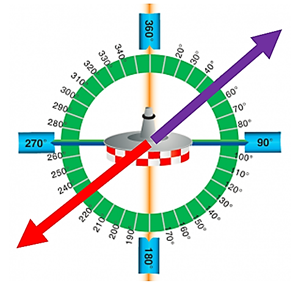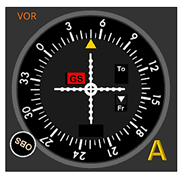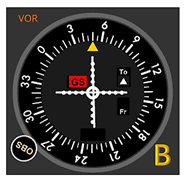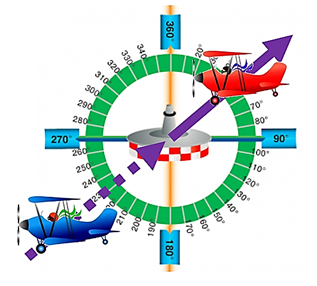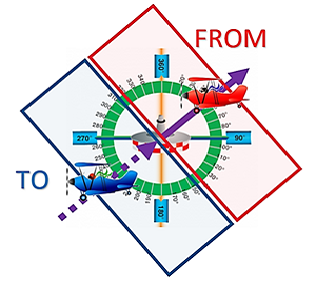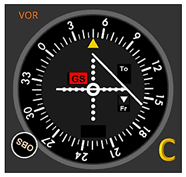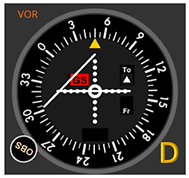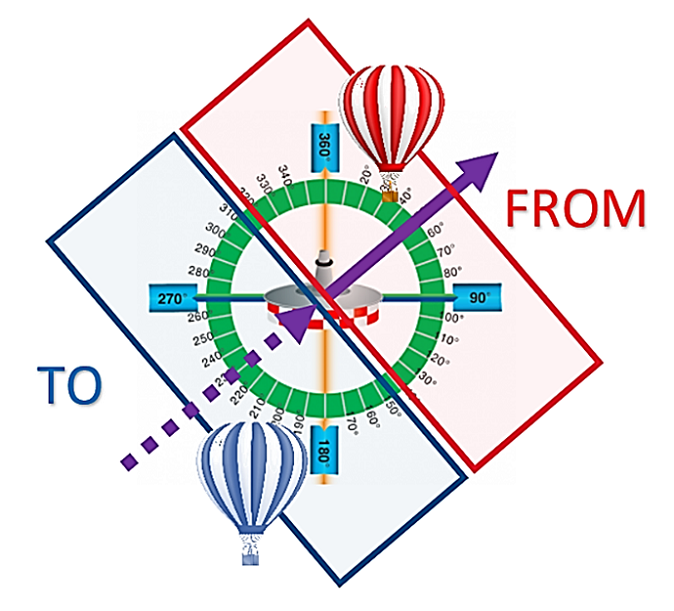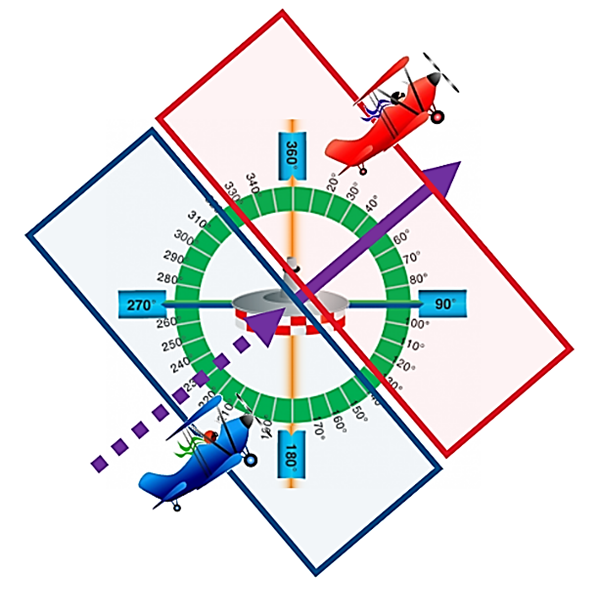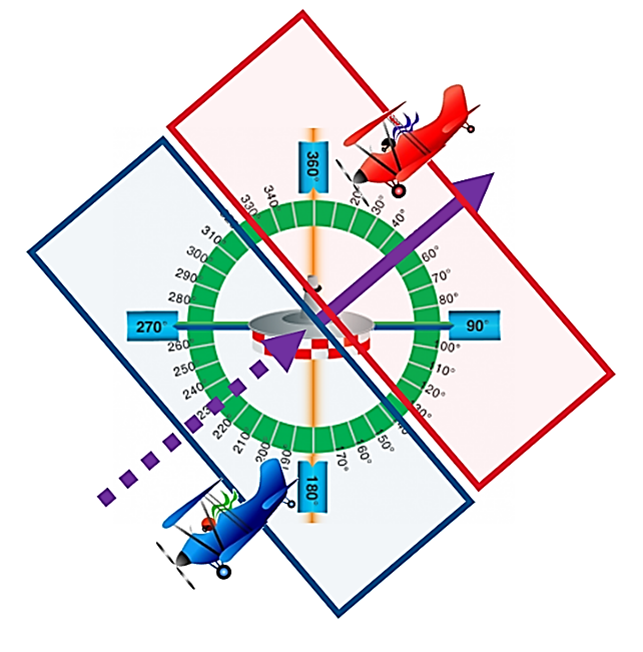by John Picone, Brantford Flight Center
The first thing is to understand how the VOR sends out its signals. We always talk about a VOR radial. So, think about the signal radiating outward from the station. The purple arrow (Figure 1) indicates the 50° radial; the red arrow lies on the 230° radial. If you had the VOR set up to choose the 50° radial—that is, you’ve turned your omnibearing selector (OBS) and put the number 50 at the top—and the course deviation indicator (CDI) was centred, then you are positioned on that radial. The same with the red arrow radial: 230°.
Now this is important: This only means you are positioned on the radial; it in no way indicates your heading. The nose of your plane could be pointed in any direction whatsoever—even up or down! Nonetheless, you are on that radial.
Here’s where it gets tricky. The VOR instrument in your plane not only has an omnibearing selector (OBS) that allows you to choose one of the 360 signals, but it also has a sense indicator which shows “to” or “from.” Well, the from is pretty straighforward: if my CDI is centred and there’s a from indication, then I’m on that radial—the radial that is radiating from the station. My VOR would look like A, (Photo A). I’m on the 50° radial.
But, what about the to indication? What if I have 50° at the top (50° radial), my CDI is centered, but I have a to indication, as in Photo B. What does that mean? Where am I relative to the VOR station? I certainly can’t be in the same spot as with a from indication. Well, if your OBS has the number 50 at the top, your VOR instrument will pick up that 50° radial from anywhere within range. Now, the 50° radial doesn’t radiate backwards. But on the southwest side of the station (blue airplane in Figure 2), because your VOR instrument is sort of behind the radial (that’s why the purple line is broken), the sense indicator points to the station (as you can see in VOR B), instead of from the station. And that’s why you get a to indication. So, Rudolph Red is on the 50° radial from the station; his VOR looks like A (Photo A). Brenda Blue, however, is on the 50° radial to the station and her VOR looks like B (Photo B).
Remember: the airplane’s heading makes no difference whatsoever!!! If you’re on the 50° radial, no matter what your heading, your VOR will read as either Brenda’s or Rudolph’s.
So, just how do you figure out where you are? The first step is to determine the from side and the to side. That’s not difficult: imagine a line perpendicular to the radial at the top of the OBS that simply divides that side of space on the side of the station where the radial radiates from the station from that side of space where the radial is, as it were, radiating to the station (Figure 3).
OK, you say, that’s easy enough. But what if I’m not on the radial and the CDI is not centered??? Now, where am I?
Good question! Here we go…
The CDI always indicates whether you are right or left of the signal you’ve chosen. It’s really quite simple and to explain it, we’re going to put Rudolph Red and Brenda Blue in hot air balloons. The reason for this will become clear to you presently. So, be patient.
Study Figure 4 below: It looks like Rudolph Red, with OBS set to 50°, is on the from side of the station and he is left of the radial. So, his VOR would look like VOR C: CDI deflected to the right because the radial is right of the balloon.
Now, what about Brenda Blue? Well, Brenda, also with her OBS set to 50°, is clearly on the to side of the station and it looks like she’s on the right side of the signal. So, Brenda’s VOR would look like VOR D. The CDI is deflected to the left because the signal is left of Brenda’s balloon.
So, where’s the difficulty in all this? Well, it might be easy to figure out with balloons because there no heading indicator! There’s no “nose” like an airplane. No front and back. Here’s where the confusion comes from. Let’s put the aircraft back in the picture.
If, in fact, both Rudolph and Brenda (Figure 5) are flying in the direction of the sense indicator with respect to the VOR station (from the station in Rudolph’s case and to the station in Brenda’s case), then things work out in a pretty straightforward manner. The reason is because the signal is, literally, on their right-hand or left-hand side. That is, right or left according to their heading indicator.
But, remember: the heading of your airplane has no bearing on whether you are right or left of the VOR signal.
Carefully consider the situation for Rudolph and Brenda as depicted in Figure 6. Although their heading has changed, their position relative to the VOR signal has not. So, their VORs look the same as C and D (on page 8).
Do you see the problem? Rudolph Red is still LEFT of the 50° radial signal! The CDI, therefore, is deflected to the right. But because of the heading Rudolph is flying, it appears—only appears, mind you—that the signal is on his left. Brenda Blue is in the same dilemma: her aircraft is still on the right side of the 50° signal, and the CDI is therefore deflected to the left but, because of her heading, she might think she is left of the signal and the CDI should be deflected to the right.
So, you ask, how do I figure out where I am? How do I avoid the confusion that seems to arise from being distracted by the heading of the airplane?
When you set about solving a problem like this, always draw a picture if there’s not one in the question. Looking at the OBS, determine the to side and the from side of the VOR signal. Then, regardless of the depicted heading of the aircraft in the question, in your imagination or on your diagram, point the aircraft to the station if the sense indicator is to; point it from the station if the sense indicator says from. At least then your heading indicator will be working with you; your sense of the right and left side of your aircraft will be consistent with the VOR signal being right or left of the aircraft. In terms of setting up your OBS on a real flight, that, of course, is the way you would navigate to or from the station. Or, you could just draw in some balloons!
